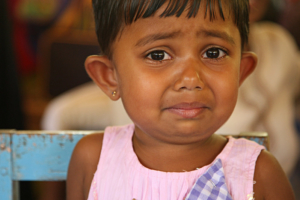Food Crisis in Sri Lanka

Record inflation and soaring fuel costs are igniting a food crisis in Sri Lanka. Skyrocketing prices leave more than 6 million Sri Lankans food insecure. Because people are not certain when their next meal will be, they reduce their food intake and that results in their poor nutrition. The health of Sri Lankan pregnant women and children is particularly at risk due to a lack of quality nutrition.
Sri Lanka Food Crisis Specifics
According to the World Food Programme (WFP), about three out of 10 households (nearly 6.26 million Sri Lankans) are uncertain of where their next food will come from. More than 60% of households are resorting to rationing their food and do not obtain sufficient nutrition. As one Sri Lankan woman said, “These days, we don’t have a proper meal but eat only rice and gravy.” In June 2022, WFP Deputy Regional Director for Asia and Pacific Anthea Webb explained, “Pregnant mothers need to eat nutritious meals every day, but the poorest find it harder and harder to afford the basics.”
At an astonishing rate of 57.4% inflation, increasing food prices have resulted in two out of five households living without enough food to support their families. In the “farming estates sector” which includes tea plantations and other similar “estates,” more than half of households live with food insecurity. These households are worse off than urban populations and other rural dwellers. Rural and urban households are depleting their savings or using credit to buy essentials. “Poor families in cities and those who work on estates have seen their incomes plummet while market prices have soared,” a WFP spokesperson commented.
Stories of Family Struggles
Perhaps one can better understand Sri Lanka’s food crisis by hearing about family struggles. Chandrika Manel, a mother of four children, expresses how crucial the situation is when she says, “even buying bread is a struggle. There are times I [give them] milk and rice, but we don’t cook any vegetables. They’re too expensive.” Sahna, a pregnant 34-year-old who has three children and is due in September, is nervous about the future, uttering, “My children are miserable. They’re suffering in every possible way. I can’t even afford a packet of biscuits or milk for my babies.” Acute malnutrition could increase dramatically from 13% to 20%. Further, the current 35,000 malnourished children could double according to Dr. Renuka Jayatissa, President of the Sri Lanka Medical Nutrition Association.
UN Warns of Humanitarian Crisis
The United Nations Children’s Fund (UNICEF) is appealing for significant funds to hold off a humanitarian crisis. UNICEF found that depleting gas and medical supplies forced 70% of Sri Lankan families to reduce their food intake in 2022. “We’re trying to avoid a humanitarian crisis. We’re not yet at children dying, which is good, but we need to get the support very urgently to avoid that,” said Christian Skoog, UNICEF’s representative in Sri Lanka.
On the positive side, UNICEF has noted a sense of solidarity and community among Sri Lankans. For example, Pastor Moses Akash began a community kitchen a month ago after meeting a single mother who survived off of jackfruit for three days. Akash meets people who have not had a meal in four months and believes the number of people waiting in line for food will increase from 50 to 250 a day because of the up-to-80% increase in food prices in June.
WFP Taking the Lead to Combat Sri Lanka’s Food Crisis
To address Sri Lanka’s food crisis, humanitarian organizations are taking the lead. The WFP kick-started an emergency relief fund of $60 million for food and nutrition to help 3 million who are in vulnerable sectors like women and children. Each month the WFP gives $40 meal vouchers to pregnant women in impoverished areas. The WFP also collaborates with local governments that provide prenatal care. Thus far, the organization has provided 88% of the 2,375 vouchers to assist 3 million people with food, sustenance and school lunches. Going against this support, 61% of Sri Lankan households are using the approach of lowering the quantity of food consumption and obtaining more food with less nutrition. Unfortunately, the food relief agency expects an estimate of 200,000 families will use that approach as the crisis continues.
The US announces $20 million in Additional Assistance for Sri Lanka’s Food Security
On July 5, 2022, at the G7 Summit in Germany, United States President Joe Biden announced that the U.S. committed to an additional $20 million in aid to Sri Lanka to feed more than 800,000 children and 27,000 pregnant women in the next 15 months. The relief grant encourages strong school nutrition for students and includes meal tickets for pregnant women. The plan also supports 30,000 croppers to improve cultivation in impoverished communities that are living in debt. U.S Ambassador to Sri Lanka Julie Chung underlined that the United States is devoted to food security, public health and promoting economic stability for the people of Sri Lanka. She commented, “This aid will feed Sri Lankan children, combat food insecurity and demonstrates our enduring commitment to the health & well-being of the Sri Lankan people.”
Despite the catapulting of inflation which can threaten the health of children and expecting mothers, humanitarian organizations including the World Food Programme and the United Nations are leading the way in avoiding a humanitarian crisis. The U.S. response to the food crisis in Sri Lanka also improves the odds of avoiding a dire humanitarian crisis.
– Jacara Watkins
Photo: Flickr
